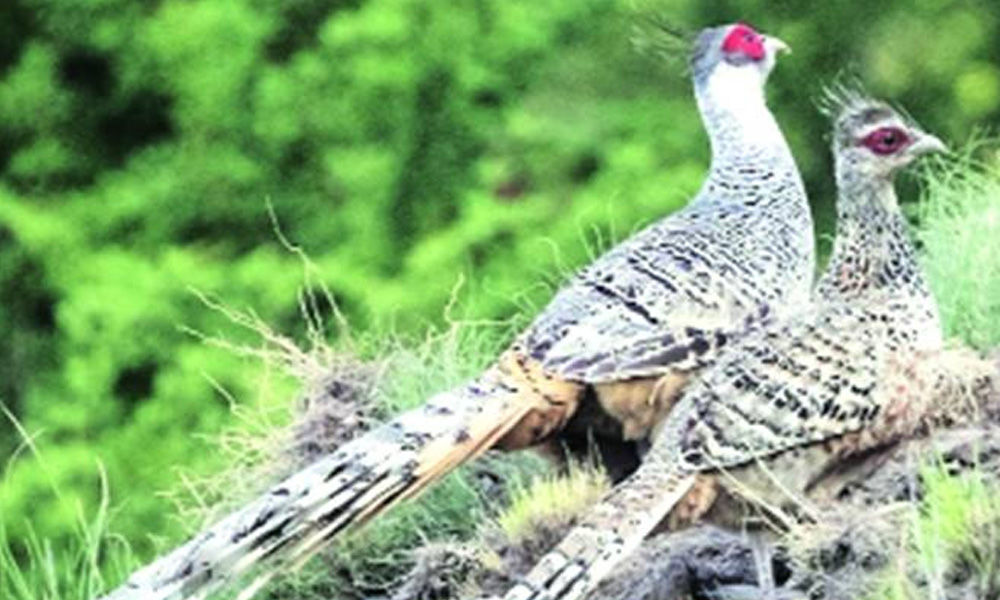Eight Of the 18 cheer pheasants which were released into a forest in rural Shimla, Himachal Pradesh, following their captive breeding, have survived for nearly 10 months in the wild.
Himachal Pradesh runs an exclusive captive breeding centre for cheer pheasants near Chail, to reintroduce the highly-threatened, ground-dwelling Himalayan bird into its natural habitat. A threatened species, they are found in the Himalayas, occurring in India, Nepal and Pakistan.
‘Cheer’ refers to the birds’ occurrence near Chir Pine forests and ‘Pheasant’ means a member of the game-bird family which mostly include ground-dwelling birds. Males and females of this species look very similar except that male birds have a relatively long tail and crest,’ said the International Union for Conservation of Nature(IUCN).
Three families of pheasants from the facility were introduced into soft-release pens at a site between Seri and Undala villages of Dharbhog panchayat in Shimla rural tehsil in October 2019.
Soft-release pens are enclosed wild spaces which act as a precursor to an actual release into the wild.
Of the 18 birds originally released, 12 are chicks and 6 adults and belonged to three different families. Of the total, 13 of the birds survived the soft-release and were subsequently introduced into the forest.
For tracking and monitoring, the adults have been fitted with identification rings and very high frequency (VHF) collars. Till date, eight of those pheasants, including three adults, have survived, according to the wildlife wing of the state forest department.
‘The surviving birds are healthy and have adapted well to their new surroundings. In fact, a couple laid eggs this breeding season (April to June),’ Principal Chief Conservator of Forests and Chief Wildlife Warden Dr Savita told the media.
The released population will be closely monitored for nearly a year till the birds establish itself into the new habitat. Meanwhile, coming October, the officials are planning to release four more families of the bird.
‘This is first of its kind experiment and if the pheasant survive for a year and get intermingled with the naturally occurring population, this would be first successful reintroduction of the bird into the wild,’ the IUCN said.
Himachal Pradesh is one area where a majority of the remaining wild populations still survive. According to IUCN, some important Cheer Pheasant areas in the state include Majathal Wildlife Sanctuary, Chail Wildlife Sanctuary, Bhaila-Chonri area, Seri and isolated areas in Chamba, Rampur and Kullu. The state Forest Department has taken a number of measures to save the species including the establishment of Protected Areas and carrying out captive breeding.
‘These sites are important Cheer Pheasant areas in the state where the number has depleted over the years and this project will help in the recovery of wild populations. This is a unique initiative and will bring the reintroduction site on the world map of wildlife conservation,’ it added.
The breeding centre at Khadiyun near Chail, located in a wildlife sanctuary, currently has 75 birds being raised in seven enclosures, which were bred according to standards of breeding as suggested by agencies like IUCN and recognised by the Central Zoo Authority. The birds that were released were selected based on their genetic constitution for reintroduction protocol as approved by Galliformes Expert Group of IUCN.
‘The vision is to re-establish populations of Cheer Pheasant in areas where they previously occurred but have now gone extinct due to various reasons including human disturbances,’ the IUCN said.
In February last year, the selection procedure for pairing and breeding of these birds were put in place. The birds were paired and allowed to breed based on the stud-book records and genetic analysis. To ensure maximum success of breeding of the selected birds, intensive management of these birds was practised.
‘A strict veterinary health screening protocol was followed up with regular sample testing to diagnose any kind of infectious processes. Feeding protocol was also spruced up to ensure a healthy constitution and rule out any feed related health issues especially mineral deficiencies,’ the IUCN said.
‘Morbid samples of the birds were collected by the veterinarians and sent to IVRI, Izzatnagar to rule out any prevalent diseases, and none of the bird was found to be harbouring any infectious or contagious pathogens. The quarantine of the birds was accomplished well in time for the final reintroduction into the soft-release facility,’ it added.
The birds are daily fed 150 grams of fruits and vegetables, 150 grams of grains, soybeans, and mineral mixture. According to an official, Pheasants can live for more than 10 years in captivity, and one bird lived for around 16 years.
Meanwhile, the release site was also thoroughly inspected for the types of predators, grazing pressure, human presence etc.
‘The birds shall be trained to waive off any kind of human-imprinting and …












